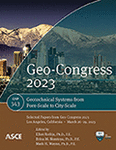Finite Line Relief Well System Design for Dams and Levees
Publication: Geo-Congress 2023
ABSTRACT
An analytical method is commonly used to design relief well systems by assuming the well line extends an infinite distance parallel to the dam or levee. This assumption may be met in some cases, but when a well line is of finite length, this can severely underestimate excess heads. Although these consequences have been historically recognized, a practical graph-based analytical approach for finite well line design has not been developed. Finite well lines exist and continue to be installed at many locations, so this study developed a practical design method for such systems. Analytical solutions and numerical models were used to improve understanding of the performance of partial and full penetration finite well systems. Performance was found to be dependent on well system geometry, the ratios of effective seepage entry and exit distances to well spacing, and the number of wells. Model results were used to develop new uplift factors that more accurately define excess heads along and landward of finite well systems that fully or partially penetrate the aquifer.
Get full access to this article
View all available purchase options and get full access to this chapter.
REFERENCES
Barron, R. A. (1948). “The Effect of a Slightly Pervious Top Blanket on the Performance of Relief Wells.” In Proc., 2nd Int. Conf. Soil Mech. and Found. Eng., Vol. 4, ISSMGE, p. 324–328.
Bennett, P. T. (1946). “The Effect of Blankets on Seepage through Pervious Foundations.” ASCE Transactions, 111 (1), p. 215–228. https://doi.org/10.1061/TACEAT.0005902.
Bennett, P. T., and Barron, R. A. (1957). “Design Data for Partially Penetrating Relief Wells.” In Proc., 4th Int. Conf. on Soil Mech. and Found. Eng., Vol. 2, Div. 3b-6, p. 282–285. London.
Darcy, H. (1856). The Public Fountains of the City of Dijon. Paris (in French).
Duncan, J. M., O’Neil, B., Brandon, T., and VandenBerge, D. R. (2011). “Evaluation of Potential for Erosion in Levees and Levee Foundations.”, Virginia Tech, 36 p.
GeoStudio. (2020). Geoslope.com. https://www.geoslope.com/products/seep-w.
Guy, E. D., Nettles, R. I., Davis, J. R., Carter, S. C., and Newberry, L. A. (2010). “Relief Well System Design Approach: HHD Case Study.” In Association of State Dam Safety Officials Proceedings, Charleston, WV, 19 p.
Guy, E. D., Ider, H. M., and Darko-Kagya, K. (2014). “Several Relief Well Design Considerations for Dams and Levees.” In Proceedings of the 45th Annual Ohio River Valley Soils Seminar, Cincinnati, OH, p. 81–106.
Guy, E. D., Darko-Kagya, K., Spagna, S. S., and Keffer, A. M. (2017). “Portsmouth Levee Foundation Erosion Incident.” In Association of State Dam Safety Officials Southeast Regional Conference Proceedings, Nashville, TN, 8 p.
Jaeger, R. A., Keizer, R. A., Bradner, G. C., Weber, J. P., and Stanley, M. H. (2017). “Advances in Design Procedures for Relief Well Lines in Variable Urban Settings.” In USSD (United States Society on Dams) Annual Conference Proceedings, Anaheim, CA, 20 p.
Keffer, A. M., and Guy, E. D. (2021). “Design Method for a Finite Line of Fully Penetrating Relief Wells.” In Proc., 10th International Conference on Scour and Erosion (ICSE-10), Online, 18-21 October 2021, p. 1284–1298.
Rocscience Inc. (2021). Rocscience Inc. https://www.rocscience.com/software/rs3.
Sills, G. L., and Vroman, N. (2007). “A Review of Corps of Engineers Levee Seepage Practices in the United States.” In Internal Erosion of Dams and their Foundations, London: Taylor & Francis Group, p. 209–218.
Turnbull, W. J., and Mansur, C. I. (1961). “Design of Control Measures for Dams and Levees.” ASCE Transactions, 126 (1), p. 1486–1522. https://doi.org/10.1061/TACEAT.0008149.
USACE. (1939a). Mississippi River Levees Underseepage Studies – Black Bayou Levee.
USACE. (1939b). “The Efficacy of Systems of Drainage Wells for the Relief of Subsurface Hydrostatic Pressures.”, Waterways Experiment Station, Vicksburg, MS.
USACE. (1949). “Relief Well Systems for Dams and Levees on Pervious Foundations, Model Investigations.”, Waterways Experiment Station, Vicksburg, MS.
USACE. (1952). “Control of Underseepage by Relief Wells, Trotters, Mississippi.”, USACE Mississippi River Commission, Waterways Experiment Station, Vicksburg, MS.
USACE. (1955). “Relief Well Design.”, Washington, DC.
USACE. (1956). “Investigation of Underseepage and its Control, Lower Mississippi River Levees.”, USACE Mississippi River Commission, Waterways Experiment Station, Vicksburg, MS.
USACE. (1963). “Design of Finite Relief Well Systems.”, Washington, DC.
USACE. (1992). “Design, Construction, and Maintenance of Relief Wells.”, Washington, DC.
USACE. (2000). “Design and Construction of Levees.”, Washington, DC.
USACE. (2018). “Comparison of Levee Underseepage Analysis Methods Using Blanket Theory and Finite Element Analysis.” Engineer Research and Development Center, Geotechnical and Structures Lab. 145 p.
Information & Authors
Information
Published In
History
Published online: Mar 23, 2023
Authors
Metrics & Citations
Metrics
Citations
Download citation
If you have the appropriate software installed, you can download article citation data to the citation manager of your choice. Simply select your manager software from the list below and click Download.
